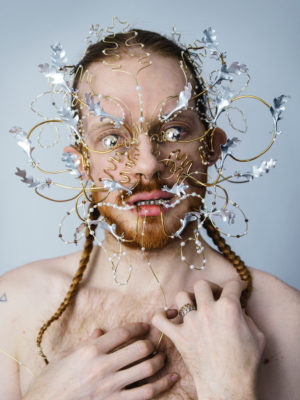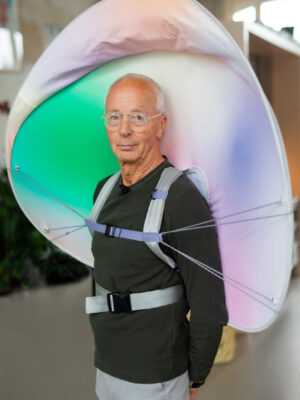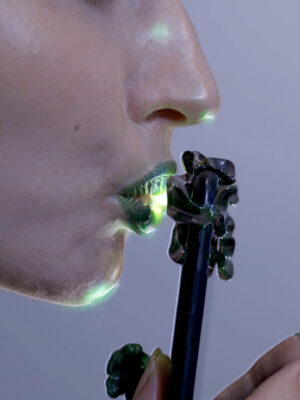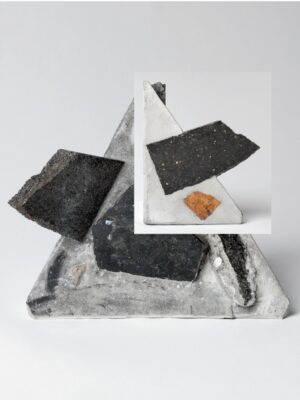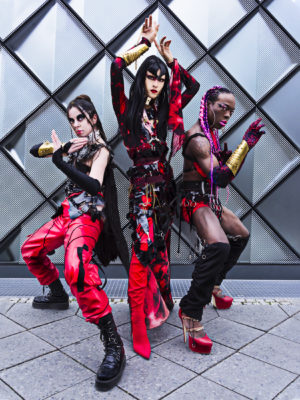These two artists may seem to be located in very different spheres – James in that of high craft, and Inès in the norm-breaking space of virtual self-representation – but they both make works capable of transforming, empowering and altering the features of their wearers. And in today’s world, the ways we present and modify our digital proxies are as much part of our self-expression as the ways we adorn our physical bodies. They do not merely overlap, they morph into each other.
Whether physical or virtual, masks and make-up give certain powers to their wearers. On stage, as a digital-animal-aquatic-floral-human hybrid – a creature given shape, in part, by James’ hands – Björk is able to share her most intimate emotions with her audience. Online, Inès seeks to broaden the scope of aesthetic expression for her followers with her 3D make-up, undoing conventional beauty standards in the process. In their disparate approaches to augmenting the human form, they allow us to creep ever closer to the supernatural.
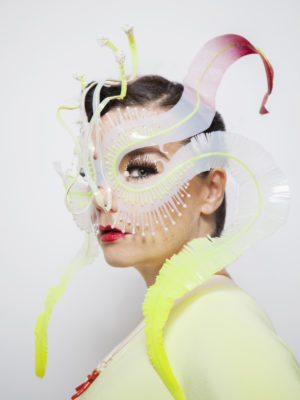
M.E.
James, your pieces belong to the majestic being, Björk; what do you think she achieves, in terms of her energy or her presence on stage, when she puts them on?
James
Björk has said a few times in interviews that the masks allow her to be more generous in public. I would guess that being an introvert in an extrovert’s job is a complicated thing, and I can see how a mask could let you relax and give more of yourself, whether you’re performing on stage or going to the supermarket. The whole mask journey with Björk began when the Vulnicura tour was starting and suddenly those very raw songs had to be performed live. So, in a way, the early masks probably functioned as a sort of protective barrier that allowed her to sing those songs to a room full of people. But I think it has grown since then into something else – a physical expression of an emotional state, revealing and concealing in equal measure. I guess there are a million books written about the performative / shaman-istic use of masks and the idea that a mask’s wearer might be imbued with the characteristics of the animal or plant that it represents. But the idea of the avatar, of playing with outward-facing identity, is something Björk has explored throughout her career – from the Hunter video, to numerous photoshoots, to the All is Full of Love robots, to the recent VR videos… So I see our masks more as a continuation of that thread, rather than something totally new.
I think it would also be foolish to ignore just the straightforward aesthetic aspect too: sometimes it can just look cool, and that’s enough too.
M.E.
For one of the previous magazine issues we investigated the supernatural as a concept that inspires a lot of makers. Do you think your work connects to this subject? And if so, in what way?
James
I think there is something supernatural about any sort of creative process. My work is usually better when I turn something off in my brain rather than on and just let my hands go on autopilot. I often feel that the process of making is more of an ‘excavation’ than a creation – like the finished piece is already there waiting, I just have to use my hands to dig the negative space around it and get out of my own way. That feels kinda supernatural to me.
For the past two years I have been studying the work of Carl Jung and have been in a weekly process of dream analysis. Besides the expected benefits of being in therapy, I undertook the process as some sort of exploration into the psyche – an attempt to establish a better connection to that mysterious fabric underlying consciousness. Since starting the analysis I have been doing automatic drawings of my dreams, and I recently noticed that some elements and shapes from those drawings have ended up in my pieces. I probably do not have enough perspective on this yet to see how it has affected my work, but I would categorise that process as supernatural in a way.
‘I just have to use my hands to dig the negative space around it and get out of my own way.’
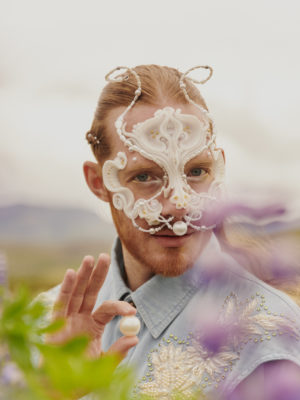
M.E.
Could you talk a bit about your process – how do you come up with pieces?
James
The process is a little different each time, but in general I try to put my antennae out and feel what sort of thing she is after – not only aesthetically, but also emotionally. What sort of character or mood is required? That is the principal question I ask myself. Björk always has quite a specific set of references – textures, colours, etc. – that she instinctively feels to be connected to each particular song or album. Those are the seeds that are sown, and then everything else will grow from them. We have been working together for over 10 years now, and there are long intertwined roots that have grown over those years, so more often than not it is unspoken. We will simply both be kind of on the same wavelength. I like to think of the head-pieces like pieces of fruit that occasionally appear on the branches of our working relationship: a little bonus manifestation of all the other subliminal stuff we are usually working on together. I will design and make them my-self, but I do that with a lot of ideas and references from her swilling around my head.
I usually make them on my own head, so the moment when she first tries them on is always really exciting – they often totally change character in unexpected ways. If it works, we will then do the final tweaks or changes together to get it just right.
Most recently I have been making headpieces for the Cornucopia tour–not only for Björk, but also for the other musicians onstage (an Icelandic flute septet called Viibra).I wanted these new pieces to be more like jewellery, so I worked by cutting sheet metal by hand, making a unique design for each player to match their look and personality so that they would look united but still have their own individuality. The different designs are inspired variously by feathers, orchids, sea creatures, sound waves,mush-rooms, and sun cycles, and I polish them before every
performance so they really catch and reflect the stage lights from a distance.
M.E.
Let’s talk about transformation and the transformative aspects of nature and of technology. James, Inès, what are some of the more ‘transformative’ intentions of your work?
James
I think a mask always has an interesting dual nature: its power lies in the dynamic between hiding and revealing, and a good one looks inwards and outwards at the same time. It always surprises me how the process of concealment can end up bringing things that would otherwise remain internal more into focus – things that are usually hidden by one’s outward personality. So, for me, the intention is rarely just to cover up. It’s also about creating a sort of permeability in both directions – a veil that acts both as a shield and as a conduit towards something more archetypal, hopefully revealing an inner truth along the way. Regarding the shapeshifting transformational aspect, I always aim for a blurring – an ambiguity. While I am making a mask there is usually a moment I know when I have hit a sweet spot: when I can’t quite tell exactly what it is – half human, half animal, half flower, half sea creature, half real, half CGI. I particularly like this location, aesthetically. Not a full transformation but the momentary halfway stage when one thing is in the process of becoming something else – not anything precisely but perpetually in-between.
Inès
I hope people are mesmerised and surprised when they try one of my filters for the first time. I hope it inspires them to play, to have fun and to tell stories and makes them more confident to show themselves to the world and to express more of their online personality. My work is all about pushing the boundaries of make-up in order to dedramatise beauty, to have fun with it. The 3D make-up series I’ve made represents my vision of the future of beauty: what people will be able to wear to feel more beautiful in their own way. 3D software and its associated technologies offer endless possibilities and aesthetic freedom when it comes to how we approach the concept of beauty. I’d rather still call my ‘filters’ 3D make-up because I don’t consider my work as a filter, as something that covers, hides or removes impurities. 3D make-up for me is the future of make-up. It’s digital, and for now it’s in AR and you need to use your smartphone, but as technology is moving very fast, I’m pretty sure we will soon be wearing it using nano-technologies or through the use of specific contact lenses 🙂
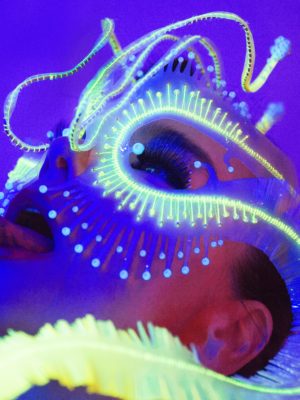
M.E.
Do you work with cultural symbolism or use socially constructed material references in your work?
James
Generally speaking, nature is always enough for me. I am instinctively drawn to things in their raw, natural state, and my references pretty much always come from there – specifically from the animal or botanical world. As soon as a human construct creeps in, it never feels quite right – it ties everything down too specifically and takes away something elemental. This is not the result of a conscious decision of course, it just happens to be what inspires me: nature in its wild state.
For some years now I have been working on an on-going series of hand-embroidered sportswear, taking vintage sweaters and embroidering natural elements by hand, starting from and growing out of their machine-made logos. I think, of all my output, these pieces probably stray the furthest into the human realm. The concept works precisely because of the socially constructed connotation it subverts: the perceived ‘femininity’ around anything floral or embroidered, which clashes with the mass-produced machine-made corporate logos.
Inès
My inspiration comes from flowers, plants, insects, fire, air… everything that comes from our planet. But also – and most importantly – from science fiction and fantasy! I have a fascination with cyborgs, mermaids, tiny sea creatures, rainbows, mineral miracles, alien algae and with holographic textures in particular. I’m inspired by shapes, colours, movements, shadows… Sometimes it’s just the person I collaborate with that inspires me: their style, the way they look, their make-up, their art, their music… Sometimes I just get lost in 3D experimentation. ‘Errors’ can lead to magnificent results. The texture of a flower, with the work of a second, can be as reflective as a mirror. I’m not trying to reproduce nature exactly – I’m building my own reality, with new rules of physics, textures and beauty.
M.E.
It seems to me that the more intangible and magical aspects of adornment are often overlooked, not taken seriously or only superficially discussed – and yet at the same time ritualistic and ‘transformative’ objects are present in every culture throughout history. What do you think the role of ‘magical’ transformative objects could be in contemporary culture?
James
I reckon we might misidentify or disregard lots of things in modern life that, though they seem to us banal or mundane, when viewed from a distance are essentially magical or ritualistic at their core. I play a lot of computer games and the whole idea of creating an online avatar and controlling it remotely in a virtual world is very much magical and totemistic. There’s much in the digital or online world that belongs in this category, but because we live so close to these things we probably don’t think about them in those terms. An Instagram filter is a great example of a so-called transformative object in the contemporary world. We have this library of masks in our pocket that we can overlay on our identity online in whatever way we choose: in order to be ironic, vain, funny, experimental. I imagine that the majority of hardcore filter users are in adolescence… in most cultures this is a transitional period in which, traditionally, identity is explored and scrutinized in a variety of ways.
Inès
The supernatural is one of the purposes of my work. What interests me the most with 3D is that I can create things that don’t exist. I can defy gravity, make animations and movements that only exist underwater, and create out-of-this-world holographic textures. It has to look magic in a way. 3D software and technologies offer endless possibilities. It’s fascinating.
I guess people will always enjoy dreaming and fantasy, getting out of a world that can be quite sad and dull. Filters are definitely a kind of magic in a way because they only exist in this digital world – they only appear through a screen.
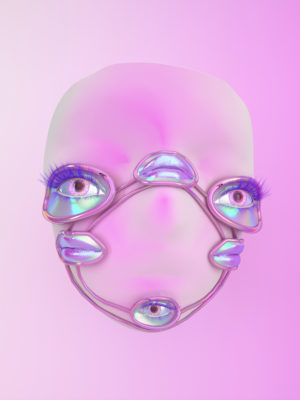
M.E.
James, your IRL, material work remains very much inaccessible, which createsthis incredible fairy-tale-like aura around it; recently, however, you have created digital 3D masks – Björchids. I’m so curious about what this transition from super exclusive to accessible to everyone, and from material to immaterial means to you?
James
Making and releasing the Björchid filter was something I had wanted to do for a while, but decided to take my time to do so that I could learn how to do all the 3D sculpting and programming myself. It’s been so cool to see fans wearing it and to have my designs available in that way. The physical things I make are all done by hand – by me, with no assistants – so they take a long time and I produce a relatively small number of objects that each have had many hours spent on them. I have always resisted the urge to mass-produce anything, mostly from an ecological standpoint and because I value the craft that goes into one bespoke object. So yes, this new digital output I saw as a cool way to offer my designs for everyone to wear.
Some of our recent explorations into VR for the Vulnicura music videos were particularly interesting to me, as the directors would often re-configure my handmade masks digitally in 3D. Seeing my physical work translated like that was oddly satisfying, and I think there has been a lot of cross-pollination back and forth between my physical masks and the CGI versions.
My real physical masks often try to have this sense of floating, with pearls lifting off the head or hovering in front of the eyes – which can be quite challenging to achieve physically. So it has been really exciting playing with that sort of thing digitally. However, I think my approach to the virtual stuff is still quite physical in essence. I sculpted the Björchid mask with my fingers using a clay-sculpting app on an iPad, so it felt like I was still moving things around with hands, just in virtual space.
M.E.
Inès, your work remains exclusively in the digital realm, accessible and ‘democratic’. Your pieces are immaterial, yet you always make sure you ‘present’ them on your Instagram as ‘real’ – laid out on a table, or sitting in a fixture. I’m curious what the transition from digital to material means to you? Why do you choose to present your work in realistic environments? Is it about imagination, and making it easier for people to relate to them?
Inès
I’ve been drawn to augmented reality ever since I started playing with 3D software. I’ve always loved making our real world more fantastic. I like to blur the frontier between reality and fiction. I want people to think it could be real; I want them to relate, to think that it could be a near future or another dimension or planet that they’re seeing! I’d love to see my creations in real life, to touch them. But as I said regarding 3D: I purposefully design things that can’t exist. And for me, the digital world is as real as the world we are living in. I’ve heard about some new technologies that will soon enable people to touch digital creations using sound frequencies, and that is going to be so awesome. The digital is getting more and more real!
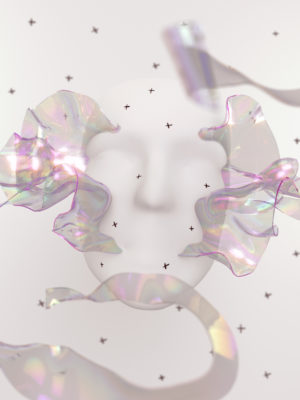
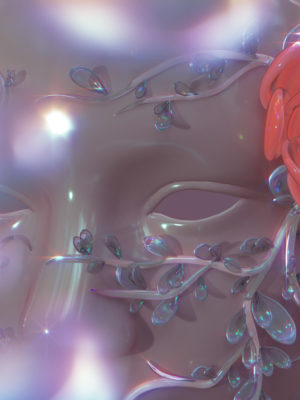
M.E.
Inès, Could you talk a bit about your process – how do you come up with pieces?
Inès
I love to collaborate. To me, there is nothing better in this world than finding the right artistic connection and uniting different skills, styles and backgrounds. I’m not really keen on working just for myself. That’s why I began asking around, asking artists I love if they wanted to wear some of my 3D make-up. Usually I ask them to send me videos of themselveslooking at the camera, acting like they are making a selfie video in order to show the world how much they love their digital make-up. Sometimes the ideas come from someone’s face, their Instagram nickname, their style, the way they dress. I search through their art pieces to get to know them better… I try to fit the make-up to their personality as much as I can. Future projects that I’m working on include more collaborations with brands as well as with other artists. The plan is to take 3D make-up further using AR technologies, but I can’t tell you more 🙂
M.E.
How do materiality and craft come in to play when working on your filters? Here I’m thinking about the necessary implications of a real- life setting, like lighting, angles, different face features, etc. What is good and not good for the filter? What do you take into account when it comes down to the believability or realness of the final look?
Inès
When I work with 3D software in post-production on my videos, I really try to push the realism as far as I can. The 3D parts have to feel like they’re real. So, I try to reproduce the same light settings as in the video, to have the right shadows projected on the face, to get the right reflections in the objects… The more you can take elements from the real footage, the more the CGI will look integrated. When making a filter, it’s different, as you will never know what someone’s environment will be like when they go to use it! For now, the filters don’t look that realistic, but they’ll definitely improve.
M.E.
Your pieces are accessible for download en masse, and they are being used by thousands of people. What do you think these people hope to achieve (in terms of their energy or their presence) when they put them on?
Inès
I hope they have fun with them! I hope that it will broaden their thinking about beauty, that it will give people ideas, that it will give them confidence, that it will inspire them to express themselves, however they want to show their faces to the world. I don’t like showing myself much on social media, especially my natural face. I’m quite shy, to be honest! But whenever I can play with a filter, it’s just different. I feel I have a good reason to do it. I feel it’s a different me. It’s not really me, it’s my online avatar. It’s fun and it’s playful! Filters have definitely helped me share more of myself to the world, so I hope they will help others too!
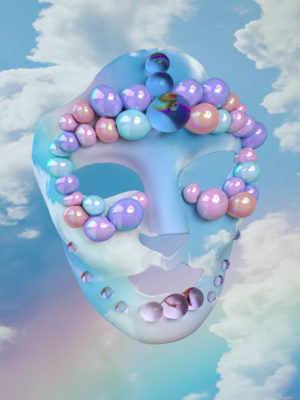
This article was published in Current Obsession’s 7th issue. Follow this link to purchase the edition.
To see more of James, follow him on Instagram
To see more of Inès, follow her on Instagram
